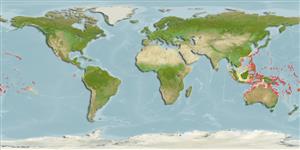Classification / Names
Common names from other countries
Main reference
Size / Weight / Age
Max length : 27.0 cm TL male/unsexed; (Ref. 9710)
Environment
Marine; reef-associated; depth range 2 - 30 m (Ref. 48636), usually 2 - 18 m (Ref. 89972)
Climate / Range
Tropical, preferred ?; 30°N - 32°S
Distribution
Indo-Pacific: Christmas Island and Rowly Shoals in the eastern Indian Ocean to the Line and Ducie islands, north to south Japan, south to Lord Howe Island.
Countries | FAO areas | Ecosystems | Occurrences | Introductions
Short description
Dorsal
spines
(total): 9;
Dorsal
soft rays
(total): 11;
Anal
spines: 3;
Anal
soft rays: 10 - 11. Light greenish to yellowish on back, white below; scale rims pink to blackish; a black spot is at the upper base of the pectoral fin; another black spot about equal to eye diameter is at the upper base of the caudal peduncle.
IUCN Red List Status (Ref. 115185)
Threat to humans
Harmless
Human uses
Aquarium: commercial
More information
ReferencesAquacultureAquaculture profileStrainsGeneticsAllele frequenciesHeritabilityDiseasesProcessingMass conversion
Tools
Special reports
Download XML
Internet sources
Estimates of some properties based on models
Phylogenetic diversity index
PD50 = 0.5000 many relatives (e.g. carps) 0.5 - 2.0 few relatives (e.g. lungfishes)
Trophic Level
3.5 ±0.51 se; Based on food items.
Resilience
Medium, minimum population doubling time 1.4 - 4.4 years (Preliminary K or Fecundity.)
Vulnerability
Low to moderate vulnerability (33 of 100)
Price category
